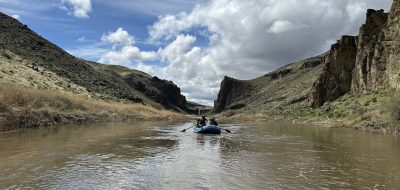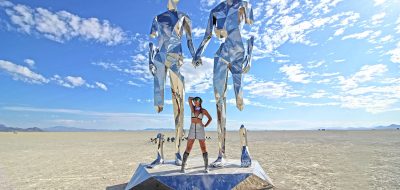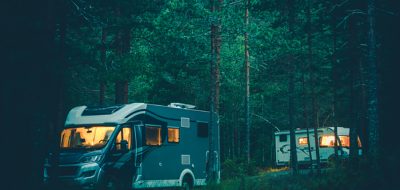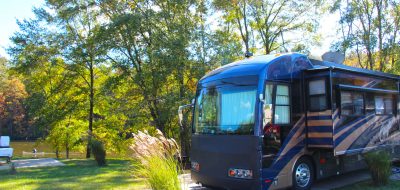The main reason I chose the RV Lifestyle was to spend as much time as I wanted in natural surroundings, in Mother Nature’s playground. RVing has enabled me to hike more trails, discover hidden Alpine lakes, track and study wildlife, enjoy the quiet and solitude of the deep forest, watch birds in their natural habitat, walk through wildflower covered meadows, and to just enjoy the natural surroundings of forests, deserts, lakes and rivers, shorelines and estuaries.
For this reason I search for little known boondocking hideaways, secluded forest service campgrounds, and the wide open desert. None of the campsites I find in these pristine spots offer amenities such as potable water supply, electrical hookup, waste tank disposal, and especially not espresso service, wireless internet access, or fresh fish market.
Often the best campsites are the most remote, several miles over a gravel or washboard dirt road, and even more miles along a two-lane asphalt connector from re-supply points. So with each trip into the back country we boondockers have devised ways to extend our stays, such as carrying extra jerry jugs of water, installing a rooftop of solar panels, a satellite dish, and a galley crammed with packaged or canned, rather than fresh, food.
We also dream of higher clearance, to avoid those muffler-extracting rocks and high crowns on the roads we travel, ability to ford small streams without shorting out the electrical system, 4WD of course, having enough storage and systems capacity to enable longer stays—extending “comfortable” living in the boondocks for weeks rather than days, and with enough convenience amenities to make the trip enjoyable and the emergency backup that would not leave us in a life-threatening situation if gear failed. This would include things like an alternate vehicle–such as an off road motorcycle, GPS, winch, air compressor, satellite phone and wireless internet dish, spare part, belt, and hose kits, huge fuel tanks, water filter system, solar as well as a large generator, and a five-star chef.
“Dream on,” you say. Sigh. Well, I expect we can’t have everything we dream of. I could eliminate the chef, for example.
Then I discovered the Unicat.

FULL DISCLOSURE: I have absolutely nothing to do with the Unicat, unfortunately. I stumbled upon it and found it to be as close to my dream vehicle as I’ve seen, including some of those German or Swiss inventions that you occasionally see around Quartzsite. But I couldn’t help putting this at the top of my dream list and letting you know about it, if nothing more than to illustrate what a perfect boondocking, nature traveling, wildland exploring, and get-a-way vehicle might look like.
For instance, they say in their video that it has a 2,000 mile range with its more than 200 gallon fuel capacity, it will ford up to a four-foot deep river, and you can stay out months at a time. But hey, since I’m giving all this free publicity to their $600,000 monster off-road motorhome, don’t you think that they ought to give me one to drive around in and promote? If you agree (which I’m sure you will), send them this email: “Hey you guys, Bob Difley is spreading the word on the Unicat, what he describes as his dream RV, and you ought to loan him one to drive around.”
If this scheme works, I promise to give all of you a free ride. But you bring the beer.








John Lefcourte
(With the trailer I’m limited in where I can go)
John Lefcourte
I do have a blue, wheeled waste container, for extended landsailing stays, but w/o the trailer I’m limited in how long I can stay by water, waste and fuel. Oh well, life is a compromise.
Bob Difley
John – Sounds like a nice compact rig. The utility trailer allows you to carry extras–like your 20 gal. of water–that don’t fit in the motorhome. You might consider also carrying a “blue boy” waste water container-on-wheels as the gray water tank size is also a limiting factor. Also, West Marine carries collapsible rubber water containers for boats (they squeeze into and fill odd-shaped bilges) for extra potable water and use a simple pump to pump it into your water tank. I like the compact size that you have, and will probably downsize myself with my next rig purchase. Every factor of downsizing can be easily handled, mostly having to do with the “things” you bring along, but the potable water and gray water waste are the biggest problems.
John Lefcourte
I have a 1999 3500 Chevy 4wd dually with a positraction rearend that I bought from an individual who built his own 21′ motorhome on it. He did a beautiful job, all himself. I added solar panels. The only drawbacks are 24 gal of fresh water and similarly small black and grey. I landsail on dry lakes and pull a small utility trailer with the landsailers and equipment so carry an additional 20 gallons of water.
Water and fuel capacity, and the consequent weight, are definitely the limiting factors.
Pingback: Boondocking on Water, Sort Of
Gary L Bloomfield
Another alternative is a vehicle modified by Quigley Motors, located near York, PA. We have a 2003 Dutchman 26Q motorhome that was converted to four (six?)wheel drive. You have a lot more choices as to what size and kind of vehicle that fits your needs and then check into whether they can do the conversion. It rose our camper up four full inches for a total of five using taller tires. Although not really designed for “off road use” per se we do spend a lot of time driving on the beach and many other places one would not normally consider taking a a normal RV into.
Bob Difley
Chris – I actually did consider a 4WD pick-up with camper. Haven’t ruled it out yet. One fear that I do have with these Unimogs and their clones is that their abilities will get people driving off across the desert rather than following the jeep trails and dirt roads. I have seen too manyexamples where ORVs and off-road bikes have torn up the desert beyond a healing point. And one of the reasons given for the endangered species ranking of the desert tortoise is that their demise was partly because of off road vehicles running over them. They do not move quick enough to get out of the way. But for forested land, these vehicles would have to follow existing roads. They don’t–yet–have the ability to mow down trees.
Chris
I want one too.
But I’ll probably have to find a used chassis (Because of the cost, maybe 4WD Ford or Chevy, instead a Unimog.) and build the camper on top myself. But to be truthful, I probably won’t have enough time to do this, between retirement, and old age catching up to me.
I’ve seen similar Unimog rigs driving around Moab, Utah. I salivated at the thought of being able to camp in the far backcountry where few vehicles can go. (Of course, anywhere within fifty or so miles of Moab now days, you’re likely to be joined by a dozen rowdy mountain bikers, so it might not be a true wilderness experience.)
However, I do know that, at least the older Mogs can’t maintain interstate speed, and are noisy and rough-riding on the highway. I’m not sure about their mileage either. Maybe the newer ones have improved highway capabilities.
A more practical alternative for us mere mortals might be a 4WD pickup with a small camper on the back. The 4WD would want to be fitted out so it had good ground clearance, high-flotation tires, appropriate suspension, full-locking differentials, etc. It would want ot be small enough to travel the jeep trails. (The Mog is really pretty large.) Some of the smaller camper manufacturers will make a custom rig for you. It would want to be small and light, but have just enough room and accessories to be livable.
John Hilley
We traveled in Europe last May in a rented motorhome. In northern Italy and Austria we saw several similar Unimog based vehicles. They all had tracks for sand strapped to them and large snorkels for intake air and exhaust.